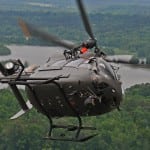
The integration of open architecture solutions on systems operating on the electromagnetic spectrum (EMS) must include considering the overall operating environment on the EMS and threats posed in the cyberspace, according to Army and Navy officials. Richard Wittstruck, the acting deputy director in the Army’s program office for intelligence, electronic warfare and sensors, said at Defense Daily’s annual Open Architecture Summit that OA systems have to be sustainable and adaptable across the EMS, including in cyber, electronic warfare, spectrum management…













